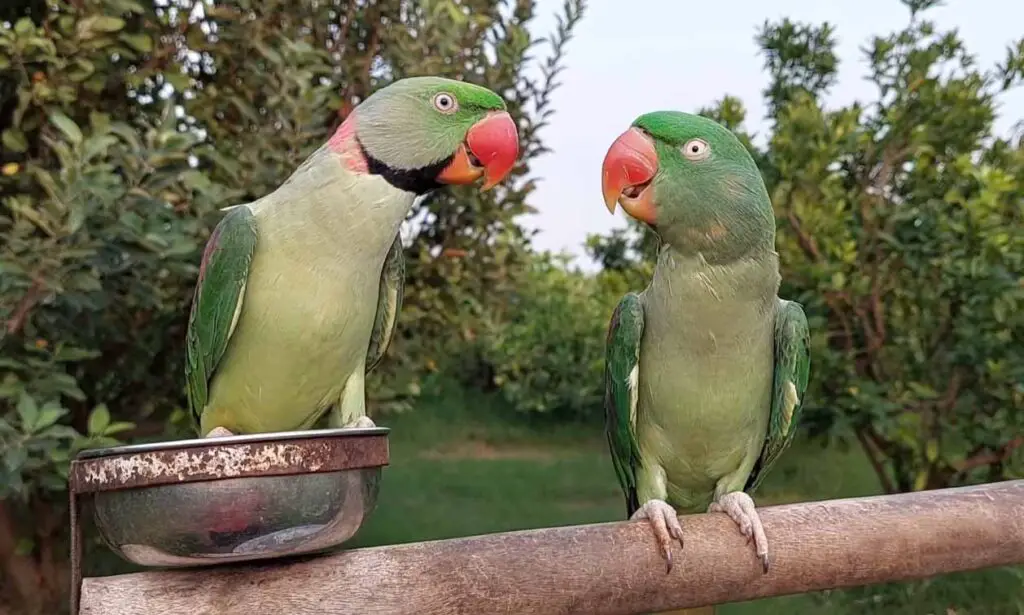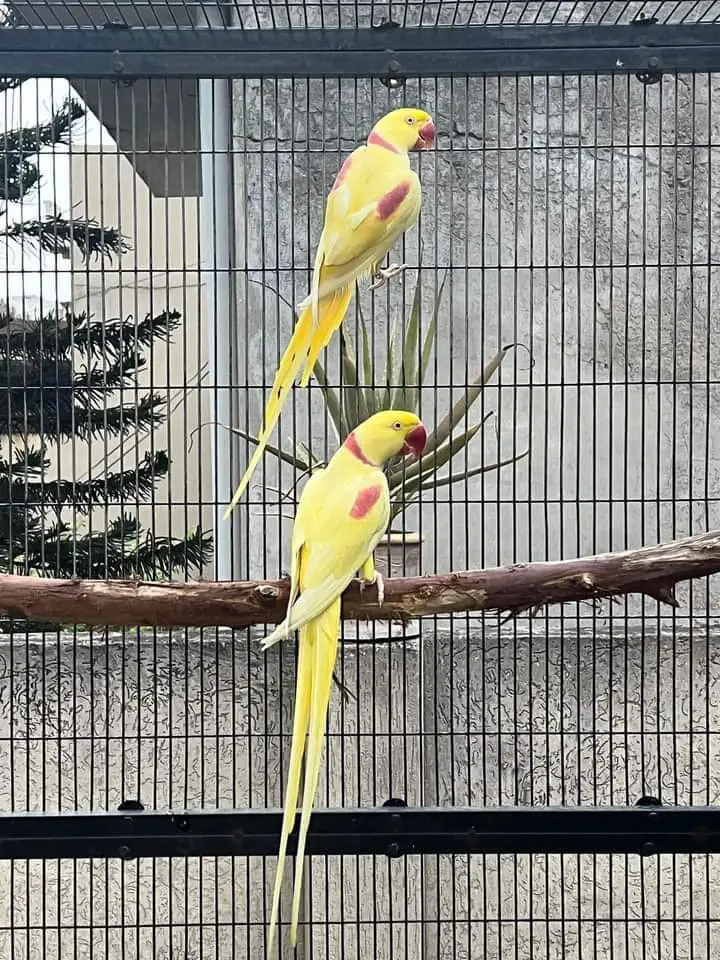Alexandrine vs Indian Ringneck: Everything There’s to Know Before Getting the One of the Birds
There aren’t many discernible differences between an Alexandrine and an Indian Ringneck. In fact, most of their behaviors are exactly the same as well.
For example, they are both known for their playful nature. But, upon close interaction and prolonged observation, I have concluded that they have their subtle differences, and these differences affect the owner’s choice.
This is the perfect guide for anyone looking forward to getting a Ringneck. This article discusses all the nuances between African Ringneck and Indian Ringneck, including personality, behavior, abilities, maintenance cost, and much more.
Let’s Discuss the Differences between These Birds!
Researching is always the right way to go if you are set to make an informed decision. Here, I have mentioned my experience of having these birds as pets. It’ll certainly help you finalize your decision.

What are Their Personalities Like?
Alexandrine parrots are usually of an extroverted nature. They are very playful and affectionate. This makes them an ideal choice for individuals and families like mine looking for an interactive and sociable pet bird.
These birds tend to be very social. They enjoy spending time with me as I am the owner.
But,an Alex (as it’s popularly known) may show signs of disturbance if it encounters strangers. Statistically, some Alexandrine prefer staying away from people.
Related reading-Are Caiques Good for Beginners?
These categories are tame and gentle. They don’t even make annoying noises like mine does. Actually, it all depends on the environment they grew up in.
Similarly, Indian Ringnecks are friendly and outgoing as well. However, I have to admit that their temperament can vary. I have seen some reserved, shy Indian ringnecks as well. Their behavior here depends on their surroundings.
From my experience, it takes patience and time to bond with such reserved birds. But once I formed that bond, everything became easy for me. With patience, even the shyest Indian Ringneck becomes a clingy one.

Do They Bite?
Both of these birds can potentially bite. I have noticed this, especially when they feel threatened or scared. What’s unique is some Alexandrine Ringneck bites when I don’t give them food at the right time.
I don’t blame them, though, but it can be an issue for those sensitive to bites. This is why I don’t let my toddler get too close to the Alexandrine in my house.
Related article-Double Yellow Head Amazon Parrot Body Language.
However, the biting incident occurred only once and was not that harsh. But, not everyone is blessed with such birds. Indian Ringnecks are popularly known for their nasty biting habit. How nasty? Well, their bite can draw blood.
My birds didn’t minimize their biting habit on their own. I actually built the habit and the training method works both for Alex and IRN.
What I basically did was, I hand feed the birds. Not going to lie, they nipped me at first, but gradually, they became calm once I gained their trust. The key is not to be afraid.

Can They Talk?
Alexandrine Parrots are talkative among birds. Mine came pre-trained, and it could mimic sounds and words in the cutest way. It even recognizes certain words I say to it and replies accordingly. It’s amazing.
Indian Ringnecks can talk, but their talking ability noticeably varies. I can get mine to talk after some training, but it’ll take time. So, for those who want a bird with strong talking ability, Alexandrine is the best option.

Do They Pluck Feathers?
Throughout my years with birds, I can confidently say that all birds pluck their feathers.
Just like the case is with any other birds, Alexandrine and Indian Ringneck pluck feathers when they are bored, stressed, hungry, anxious, nervous around new people, or have some sort of skin disease.
Although, I have noticed a slight difference in the feather-plucking habits of these two birds. And the difference is Indian Ringnecks are more prone to pluck feathers than Alexandrine. The reason is that the Indian Ringneck are more likely to be easily stressed.
But this is not a problem because doing regular things like keeping the birds busy and well-fed should keep this issue at bay.
However, Alexandrine can be the better option for busy bees, unsure if they can afford the time to create that stress-free environment.

Are They Good Around Children?
I have both birds at home and two toddlers running around the house all day. Their cohabitation is not a problem, thanks to my close supervision.
I’m not going to lie. At first, I was also worried. But, after properly introducing the birds to the kids, they play together. I also had to teach the kids to behave properly with the bird.
From this, I realized that these birds can be suitable for crowded families with children if everyone respects the bird’s space and safety.

But, this will not always be the case. Even if I realize that my pet bird is interacting politely with the kids, I don’t allow prolonged playtime.
I love my birds but I don’t trust their animal instinct. They can bite or scratch the toddlers at any time and there’s no telling what might trigger them.
So, my suggestion would be to minimize the playtime or to prevent the interaction between the kids and the pet birds.

Are They Loud?
Alexandrine Ringneck are quite noisy. I mostly notice their screeching and screaming during the active hours. This is why I would not have them around if I lived in an apartment or shared living space. It’s also not the best bird for those looking to get a quiet environment in the house.
Similarly, Indian Ringnecks are pretty loud as well. But, if I dare compare, my Indian Ringnecks are louder. What’s annoying is, they sometimes repeat the same sound over and over again.

But, I got used to it over time. If you have a bigger house, I suggest going with Indian Ringneck. This way, their sound won’t appear that intense. But if you feel that your house is small, then it’s best to choose Alexandrine.
However, in some cases, I have seen Alexandrines with louder vocal range. Well, some might say it’s more shrill than loud. From what I have heard, they can get as annoying as a constantly ringing alarm clock.
Related articles–African Ringneck vs Indian Ringneck: Which Bird Can Be Your Buddy if You Are Starting Out?
What Do They Eat?
I can’t complain at this point about either bird. Both are generally good eaters. I have tried a variety of foods, and they would eat everything. Now, their balanced diet includes fruits, vegetables, seeds, and, if you want, you can also give them pellets.
What I love most is that the veggies and fruits you eat are perfectly suitable for them, so you don’t need to make any extra purchases.

Can They Be Trained?
Both of these birds are known for their intelligence. But, they need to be trained in the right way. With proper training, they can learn to talk and play interesting tricks. This makes both birds suitable for people who enjoy training their pets.
However, in the process of training these birds, I couldn’t help but notice that an Indian Ringneck takes slightly more time to adapt to a new skill compared to an Alexandrine.

What Are the Health Concerns Involved?
If you own a pet, you must make regular vet visits. Although neither of my birds has fallen ill to date, I know they usually suffer from skin issues, digestive problems, and, in some cases, respiratory problems.
Not to brag, but I didn’t have to see any of these issues in my birds because I ensure proper care. They are not sensitive birds in general. So, the right maintenance should keep them healthy.
However, these birds can raise health concerns for the owners. Both these species can produce feather dust. It may not be suitable for sensitive and severe respiratory issues. But proper ventilation and cleaning should help mitigate this concern.

How Much Do They Cost?
Both of these birds are moderately costly. It means they won’t suck the life out of your wallet. Here’s what I have calculated,
Considering the cost of the food, toys, vet visits, and other expenses, I have to spend around $50 to $100 on my Indian Ringneck. But this cost is slightly higher for Alexandrine Ringneck. Here, I have to spend around $100 to $200.
They eat a bit more than Indian Ringneck, and thus the difference. As you can see, there’s nothing to worry about if your concern is the budget. But, if you want to save some money, I would recommend the Indian Ringneck, although it won’t make much of a difference.

How Do They Look?
If you do a search on the Alexandrine and Indian Ringneck on the internet. You will see two similar-looking birds, and you won’t be able to tell them apart. But in truth, there are more variations than you think. The differences are mainly in their size and color.
The size is the primary point of difference. On average, an Alex tends to be 22 to 24 inches while an IRN is about 14 to 17 inches from the top of the head to the tip of the tail. Although, it goes without saying, the size varies depending on the age.
Alexandrine comes in dark green, gray-green, turquoise blue (my favorite), blue, lutino, grey-green, albino, and albino gray. Some other rare color mutations may exist as well.

What’s unique in appearance is, Alexandrines have a red patch on both of its wings. Though it’s nothing huge, it gives them a distinctive look.
However, in the case of Indian Ringneck, I have commonly seen them in bright yellows, greens, blues, albinos, cinnamon, and lutinoes.
Usually, they come in green, but they have over 200 color variations. No matter what color you choose, just keep in mind the color that compliments your household.
However, just like the case is for Alex, IRN color variations come from genetic mutations which may not be entirely ethical. But in the end, the choice is actually yours.
My Final Few Words
If I were to choose between Alexandrine and Indian Ringneck, I wouldn’t be able to do it. It’s not that I can’t identify the differences but because I love them both for these differences.
The cozy friendly nature of the Alexandrine keeps me in a lively environment. At the same time, Indian Ringneck makes me feel comfortable with its exclusive intimacy. However, you probably have a specific set of requirements in your mind.
If you have read this article, you have identified the bird that fits all that. Thanks to the tiniest nuances, you get a lot if you choose. And the diverse color options make everything more interesting.
If you want a bird to interact with, go with Alexandrine. But if you live alone and want a bird to play with when you are not busy, then Indian Ringnecks are the way to go.
